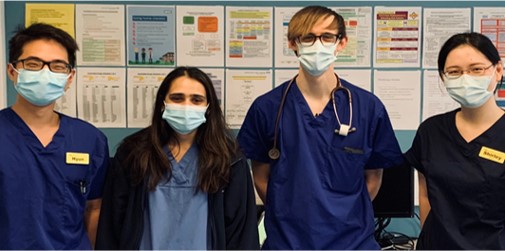Below are case studies of ‘Be the Change’ projects that we hope you will find interesting and inspirational. Click on the project titles to access the full case studies and do get in touch if you would like to find out more about any of these.
You can always ‘submit your idea’ here if you have an improvement you would like to make
east to west Hospital Project
Since 2019, ASPH have been partnering with local charity east to west to provide support for young people in mental health crisis attending the SPH A&E department. The team now provide 6 evening sessions per week and offer support to young people and their families at these very difficult and concerning times. The project has developed over the years with a growing team of volunteers able to provide more and more hospital sessions and are also now able to offer follow-up support in the community and in local schools.
Enhancing the Presentation of Data for Clinical Governance

The Clinical Effectiveness team highlighted a problem that the information presented within clinical governance reports was insufficient to enable teams to identify areas for improvement or highlight causes for concern. The team worked with local Divisions to develop run and SPC charts that give much clearer information and provide greater assurance. Feedback received has demonstrated that the new format has stimulated more focused discussions within the meetings.
Hot Clinics in General Surgery to Reduce ED Attendance

The ASPH Accident and Emergency department (ED) has seen an increase in patients who present with surgical problems that are not hyper acute, but some of these patients are unwell and cannot wait for an outpatient appointment.
This group of patients are at risk of having long waits in ED to be seen by a general surgical team. Any treatment that they receive may not be in a timely manner or they may be seen by a different team to the one they are known to, if they have been recently discharged.
Surgical ‘hot clinics’allow general surgery patients to be seen promptly, for a variety of reasons including post discharge follow up, drain review or ED referral. This results in reduced re-attendance at ED, reduced OP waiting times and an overall better patient experience.
Frailty – Everyone’s Business


The 2021 Getting it Right Frist Time (GIRFT) report identified that 53% of patients over 75years attending Emergency Departments (ED) are admitted to hospital. Once admitted, these frail patients run the risk of getting over medicalised, subsequently staying longer in hospital and increased risk of nosocomial harm; deconditioning, further frailty and dependence for health and care needs and increased morbidity and mortality. The ASPH Frailty Team set out to test some changes to improve early identification of frailty patients within ED and early intervention from the dedicated team to facilitate same day or under 24hr discharge.
Reducing Decision Making Times for Women on the Fertility Pathway

Over the last few years the Fertility Services at ASPH have been developed to create a well recognised service for women. However, with increasing demand, the team were encountering problems with tracking and managing expectations.
A process mapping event was held to understand the process and identify areas for improvement. Relevant changes were made and waiting times reduced by 4 weeks, easing anxieties for patients waiting to get started on the pathway.

Paediatric Dietetics Outpatients
The Paediatric Dietetics department at St Peter’s Hospital provides both inpatient and outpatient service. The outpatient department sees approximately 60 patients per month for a range of clinical conditions. At the start of the project in March 2019, the DNA rate was 15 – 20%, which represents a significant number of missed appointments. The aim of this project was to ensure optimal use of clinical time and resources for Paediatric Dietetics Outpatients by investigating the incidence of DNA’s and to establish whether the capacity of follow-up appointments available met the demand required.

Improving the Consistency and Quality of Ward Handovers
Good handovers are essential to allow continuity of care in shift-based work, recognition of unwell patients and effective prioritisation of jobs. Poor handover can lead to preventable patient harm, particularly when handing over to a weekend team.
The team reviewed handover information and then carried out a series of PDSA cycles, evaluating the quality of the handover information after each change.

Better Nutrition in Care Homes: BeNCH
Malnutrition is a common concern within Care Homes with up to 42% of Care Home residents at risk (1). In NW Surrey there are over 2500 Care Home beds for older people across 48 Residential or Nursing Homes. Disease related malnutrition can lead to complications . Optimising nutritional care within Care Homes is essential, particularly given the additional challenges of COVID-19.
This project set out to to develop, test and evaluate a training program specifically for Care Home staff to improve knowledge and understanding of nutrition and hydration.
The team are now working to extend the teaching to Learning Disability homes and with individual Care Homes on how they can adopt the training within their home and monitor for improvements and identify the next topic of training that would be beneficial.

IMPROVING PAEDIATRIC PREASSESSMENT
The team on Oak Ward felt that the admission process for children prior to their elective surgery was too busy and often chaotic and invariably did not include essential play preparation. This could lead to incidents of children panicking in the anaesthetic room, negatively impacting on the experience of children, parents and staff. The team decided to test the introduction of a pre-assessment clinic, patient video and allocated slots for the play team with dedicated time to prepare children for surgery; all of which led to a measurable improvement in understanding of surgery and improved experiences for patients and staff.
REDUCING THE RISK OF ‘MISSED FRACTURES’
Over a number years, the Emergency Department (ED) team reported a number of serious patient safety incidents relating to a fracture, which following radiological review, was not recognised by ED staff, leading to the patient receiving delayed or inappropriate treatment. The ED team decided to begin a quality improvement project to improve patient safety and communication between clinicians in ED and the radiology reporters.

IMPROVING COLORECTAL WARD ROUNDS
In 2016, the ASPH Colorectal Surgical team felt that the experience that many patients have of surgical, daily ward rounds was poor. The team set out to undertake a quality improvement project with a vision to improve patient experience and increase collaborative multi-disciplinary working and communication, by making changes to the Colorectal ward rounds.
CREATING A DEMENTIA FRIENDLY AREA IN OUTPATIENTS
For patients with dementia, attending an outpatient appointment at Ashford Hospital – navigating the department, waiting for their appointment in an unfamiliar environment and spending time in a very busy, and potentially noisy waiting area – can potentially be difficult and distressing.

ED ASSEMBLY
The Emergency Department (ED) Assembly is a simple method of bringing staff together to facilitate improvement and better team working. It is a platform for effective communication, in which there is no hierarchy and everyone is encouraged to contribute. See their poster here.

ADOPT A GRANDPARENT
Imagine… you are an elderly patient in hospital; in bed, all day, no social interaction. The nights are filled with the cries of strangers around you, stopping you from sleeping. Can you imagine the effect that this would have on you after 5, 10 or 50 days and nights?

IMPROVING DISCHARGE INFORMATION FROM THE EMERGENCY DEPARTMENT
A project to ensure the safe transfer of care to primary care for all patients who have attended urgent care by improving the completion and quality of information in ED discharge summaries by March 2017.

ROADMAP (RISK OF ASPIRATION DECISION MAKING ACTION PLAN)
A project to improve decision making processes for patients at risk of aspiration on all oral intake, and increasing the percentage of who have documented evidence of a completed metal capacity assessment (MCA).

CHANGING THE TIME OF WARFARIN ADMINISTRATION
Warfarin is a commonly prescribed high-risk medicine that has the potential to result in significant side effects if prescription and administration are not carefully controlled.
Improving surgical clerking
The surgical clerking, or the initial documentation of contact with the surgical team, is the primary documentation of the presenting issue, the patients background the diagnosis and subsequent plan… read more
Junior doctors guidelines app
Junior doctors are often the first doctor to be called to see a sick patient, either on an inpatient ward or on-call… read more
Re-Feeding
A project to assess how well doctors check and replace electrolytes in patients identified at risk of re-
feeding syndrome, with the aim of addressing reasons for any poor compliance… read more
Weekend plans
Weekend and out-of-hours ward cover is challenging when a team is asked to see patients with whom they are not familiar. We surveyed junior doctors for their views… read more
Aspen Drug Charts
The team on Aspen Ward – Nurses, Doctors, Pharmacists and Allied Health Professionals (AHPs) were finding locating the patients Drug Chart a problem; this was often a challenge when the patient needed analgesic medications… read more
Dotty for Directions
During the first ‘Be the Change’ campaign, the portering and security teams identified a problem with patients and visitors finding their way around the hospital… read more
 Nurse Role Badges on Oak and Ash Wards
Nurse Role Badges on Oak and Ash Wards
The Paediatric wards reviewed compliance with the
drugs policy. They highlighted that controlled drug checks were not being performed consistently and as required…
read more
 Pathology Network News Letter
Pathology Network News Letter
The SPS Newsletter was developed to celebrate achievements across the network and advertise tutorials, events and to include articles of interest mainly but not exclusively relevant to Pathology… read more
 Paediatric Treatment Room – Out of this World!
Paediatric Treatment Room – Out of this World!
The treatment room on Ash Ward (Paediatrics) had recently been renovated and was left with bare walls. There was no
indication that it was a paediatric area of care and not very child friendly! read more
 Maple Discharge Summaries
Maple Discharge Summaries
In January 2015 Maple Ward chose to address the timely completion of patient discharge summaries as part of their
‘Releasing Time to Care’ discharge module… read more
 Visual Identification of Medication
Visual Identification of Medication
Kingfisher Ward undertook the re-organisation of their drug trollies to improve their medication rounds and new signs
were devised to enable the grouping of similar drugs adjacent to each other within the trollies… read more
 Swan Ward Handovers
Swan Ward Handovers
In May 2015, Swan Ward reviewed their nursing night handover which they identified as containing excessive information which, along with interruptions, resulted in delays… read more








